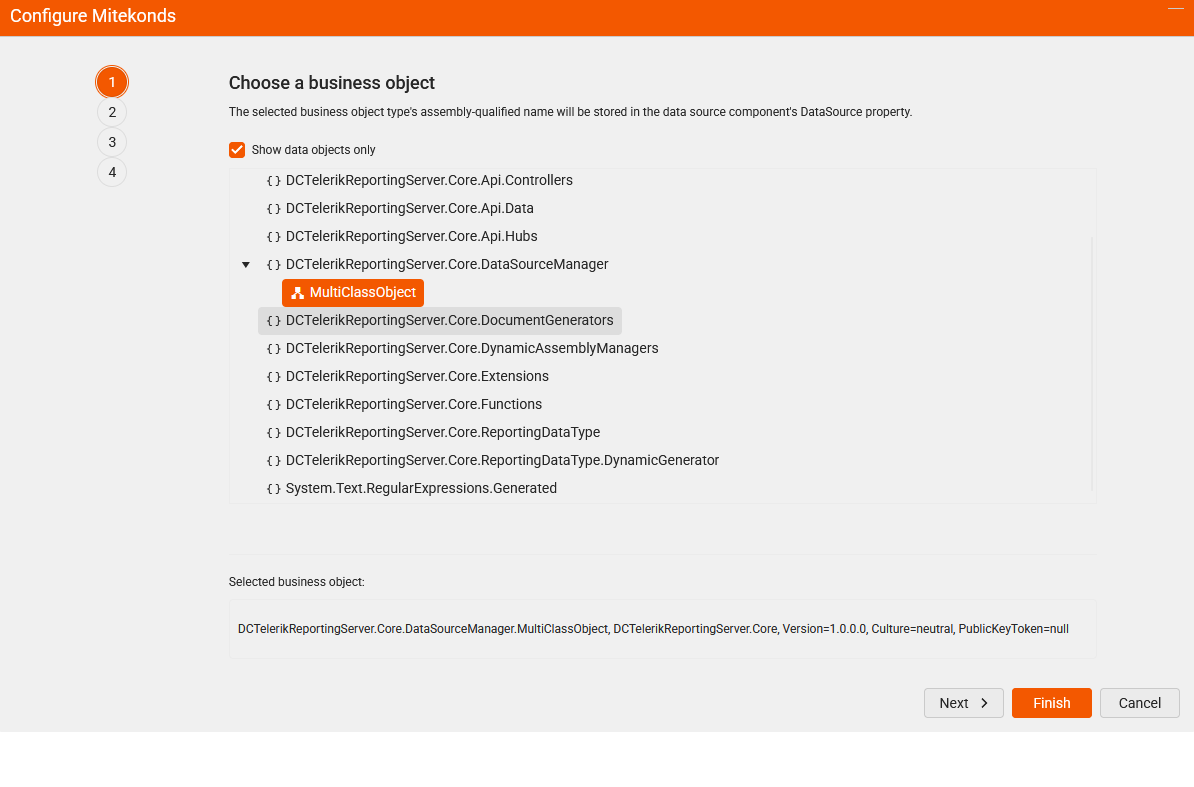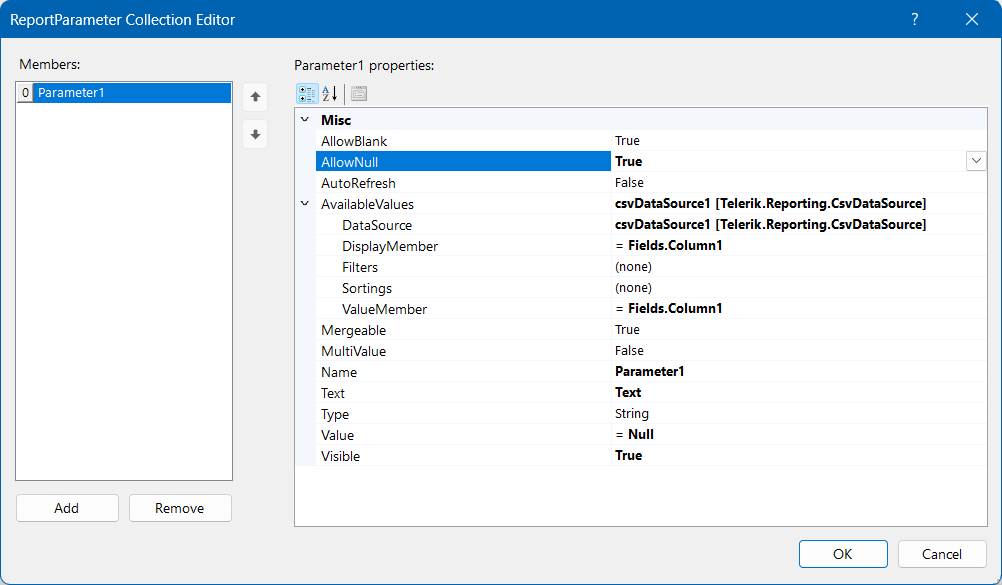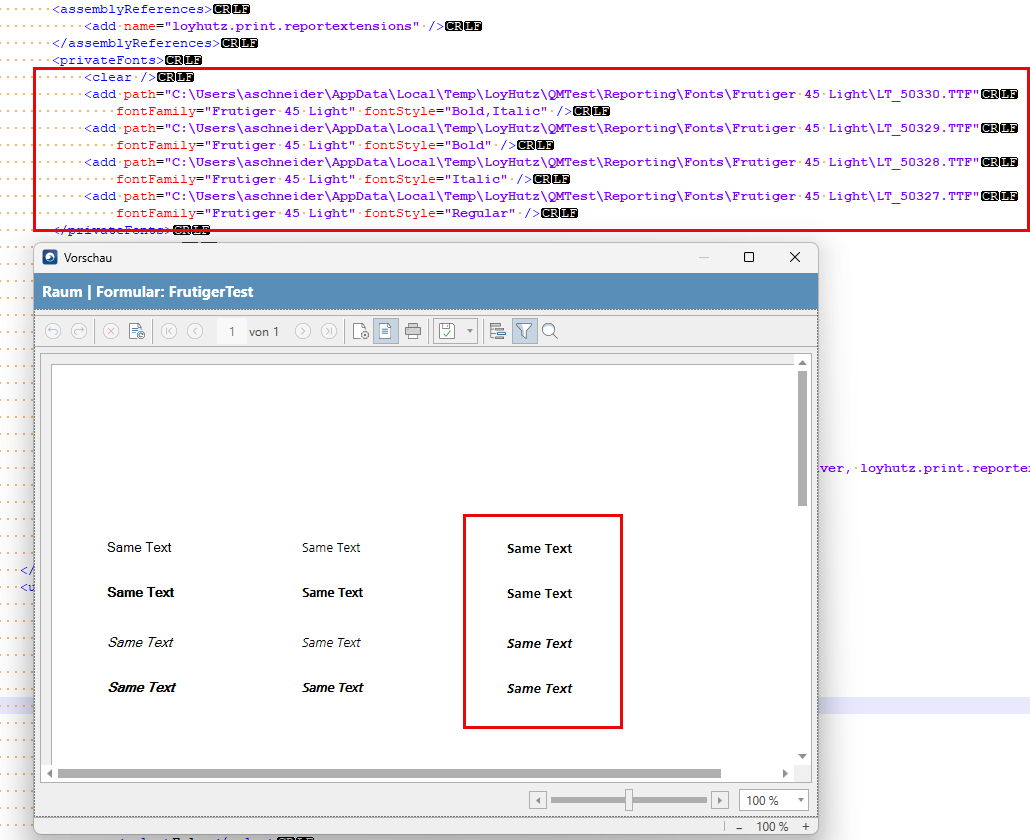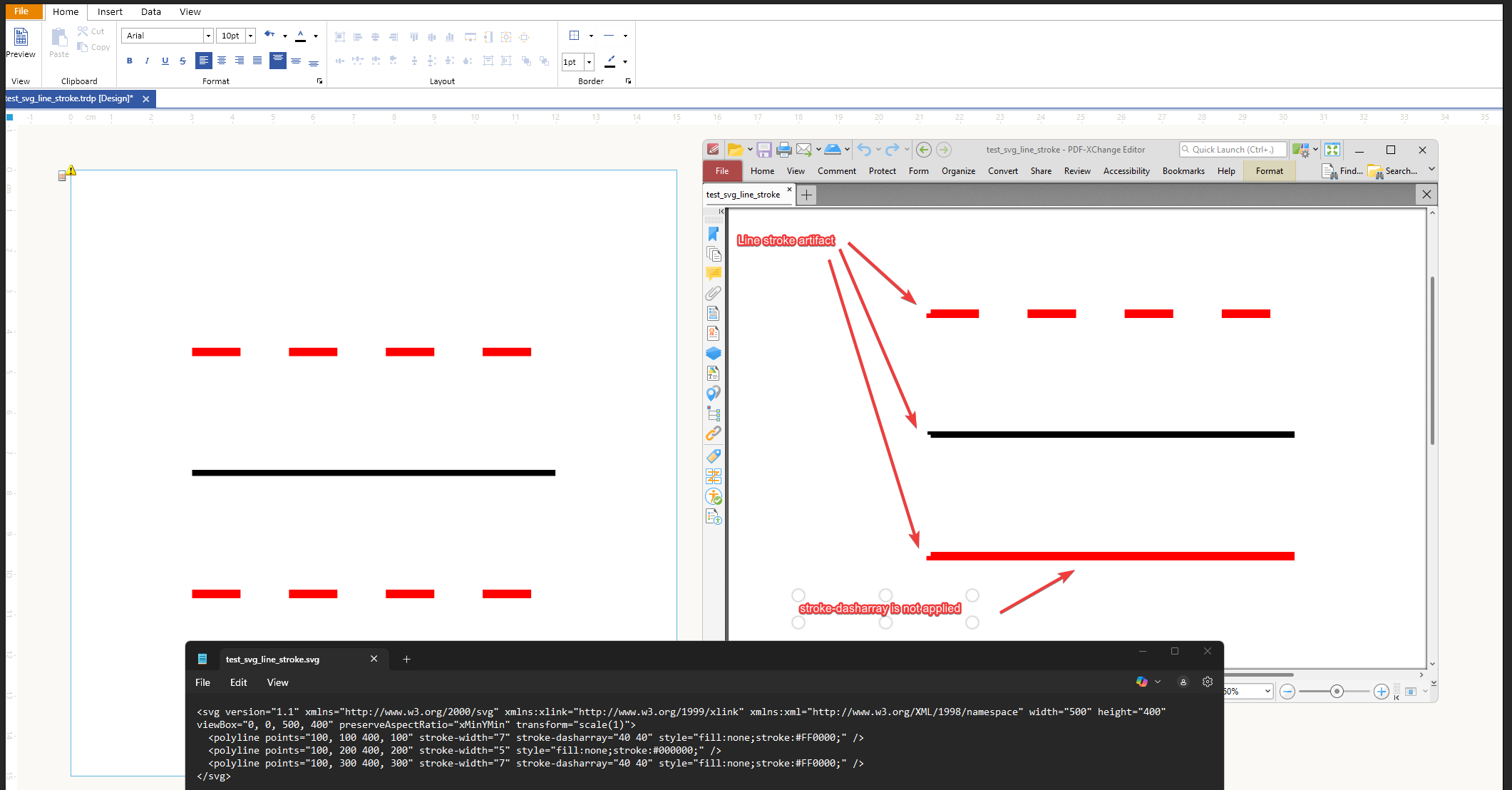With the 2025 Q2 release, the 3-parameter AddTelerikReporting static method was replaced with a 4-parameter method containing an additional argument for the optional AIClientFactory method of the REST Service.
The original method should be returned to avoid breaking projects that do not implement an AIClientFactory.
I’m working on a project that requires generating Section 508-compliant PDFs, and I’m using Telerik Reporting to build the accessible reports. However, I’ve run into a problem with how screen readers—specifically NVDA—are interpreting table content.
In my report’s table, some values like 12/01/2023 aren’t being read as dates, and values like (192,340.00)—which represent negative numbers—aren’t being interpreted as “negative” or addressing the parenthesis.
As soon as I set an AccessibleDescription on a cell (especially the first cell in a row), NVDA stops reading the rest of the row. It seems like the table reading order is broken, and the screen reader exits the table structure or skips over the remaining cells to go to the next row.
This is obviously a problem for users relying on screen readers, and I’m not sure how to fix it. Has anyone else dealt with this in Telerik Reporting, or know a workaround to make screen readers read both the custom alt text and maintain proper row navigation?
Hi
Currently, when referencing an assembly from appsettings.json in telerikReporting:assemblyReferences , the Object Data Source wizard in Telerik Web Reporting displays all namespaces from that assembly, even if only one class is marked with [DataObject]. This results in unnecessary namespace clutter and can confuse report designers, especially in large projects where only a single data object is intended for reporting. See screenshots below:
Please provide a way to control which namespaces and/or classes are visible in the Object Data Source wizard. Possible solutions could include:
• Only displaying namespaces that contain [DataObject] classes (filtering namspaces with no elments to display)
• Allowing explicit inclusion/exclusion of namespaces or classes via configuration (e.g., in appsettings.json).
• Supporting an attribute (such as [Browsable(false)] or a new custom attribute) to hide specific classes or namespaces from the wizard UI.
Thank you for considering this improvement!
I have created a report parameter that accepts null as a value(AllowNull=True) and have set null as the default value by using the expression =Null on the Value property of the report parameter.
This report parameter also has a data source assigned to it so it has available values. Here is a look at the full setup:
When I call the "getReportParameters()" function on the HTML5 Report Viewer, there is an exception thrown in the console that looks as follows:
telerikReportViewer:1 Error: The available values of parameter Parameter1 do not contain Value property that equals null
at Ae (telerikReportViewer:1:45529)
at Object.getReportParameters (telerikReportViewer:1:38265)
at Object.getReportParameters (telerikReportViewer:1:108469)
at <anonymous>:1:50
I have a main report - "MainReport.trdp" and a report that I use in the detail section of the main report as a subreport twice - "SubReport.trdp".
In "SubReport.trdp", I have a report parameter whose value I use in one of the calculated fields in its data source component.
The calculated field's expression is evaluated based on the report parameter value passed with the SubReport's ReportSource object of the first SubReport item for both subreports.
For example, if I pass the string "A" to the first subreport's parameter and the string "B" to the second, the calculated field in both instances will evaluate based on the first value, in this case - "A".
The second subreport should evaluate the calculated field based on the value passed to its report parameter, it should not matter if I have the same report rendered as a subreport multiple times and whether a different parameter value is passed to them.
Hello SupportTeam,
when using privateFonts, the WPF-ReportViewer does not use the correct-FontFile when multiple Font-Files are present in the same folder.
The used Graphics-Engine is GDI.
Example 1:
When putting every File in its own Folder it works as expected.
Example 2:
During debugging, we noticed that in case of WPF, the Directory is passed instead of the Full file Path:
In class: Telerik.Reporting.Processing.Common.FontContainer
Best regards
Alexander Schneider
I am using the HTML5 Report Viewer and have a multi-page report. When the report is previewed with the default pageMode setting, where pages are continuously scrollen into, the found search results are correctly highlighted.
However, if I use pageMode="SINGLE_PAGE" in the HTML5 Report Viewer initialization code, and I navigate to page 2 or further, the found results are not highlighted.
I run an ASP.NET Core application that has the functionality to export reports into PDFs in an Azure environment.
There is no way to install additional fonts on Azure so I provide the fonts used in my reports via the "privateFonts" element of the Reporting configuration.
This works for the most part, the font is embedded in the produced PDFs but if I have a textbox with a large text, the text may be cut off when using the Skia engine.
I tested running my application in Docker, I copied the needed fonts in the usr/share/fonts directory of the Docker Linux container, and tried exporting again.
When exporting from Docker, with the fonts installed in the container, the text is not cut off. It seems that there is an issue when the fonts are provided as private fonts.
When exporting an SVG image to PDF, polylines with stroke-dasharray are rendered incorrectly — the dash pattern is not applied.
Additionally, polylines with a stroke-width exhibit visual artifacts such as pixelation or inconsistent thickness.
Step by step instructions or code snippets how to reproduce the problem
- Save svg content (see below) as a file c:\test_svg_line_stroke.svg
- Create an empty report
- Add a picture box
- Select a value for the picture box - use file c:\test_svg_line_stroke.svg
- Go to preview - SVG is correct
- Click Export->Acrobat (PDF) file and export a PDF file
- Open PDF file to verify that the red line in a bottob does not have stroke-dasharray applied
If there's no black line with no stroke-dasharray - the red line in a bottom looks correct
test_svg_line_stroke.svg
<svg version="1.1" xmlns="http://www.w3.org/2000/svg" xmlns:xlink="http://www.w3.org/1999/xlink" xmlns:xml="http://www.w3.org/XML/1998/namespace" width="500" height="400" viewBox="0, 0, 500, 400" preserveAspectRatio="xMinYMin" transform="scale(1)">
<polyline points="100, 100 400, 100" stroke-width="7" stroke-dasharray="40 40" style="fill:none;stroke:#FF0000;" />
<polyline points="100, 200 400, 200" stroke-width="5" style="fill:none;stroke:#000000;" />
<polyline points="100, 300 400, 300" stroke-width="7" stroke-dasharray="40 40" style="fill:none;stroke:#FF0000;" />
</svg>
test_svg_line_stroke.svg - svg source file
test_svg_line_stroke.trdp - report with a picture box with SVG image
test_svg_line_stroke.pdf - generated PDF file
Greetings,
Telerik.Reporting version: 19.1.25.521
ASP.NET Web Forms
Our team recently had a some trouble understanding the behavior of the ReportViewer.ParametersArea and the property "ParametersAreaVisible". Our desire was to hide this to the end user because the ParametersArea should not be fiddled with directly by the our end users; sensitive data could be accessed. Setting this to false does not stop the render of the ParametersArea. Typically setting the property on a control in ASP.NET Web Forms means the control will not render to the page. So having a property named "ParametersAreaVisible" is misleading in my opinion. I know the ParametersArea is thought as a benefit to the end user but in our case we do not desire this.
My feature request is to add a new property "DisableParameterArea" to the ReportViewer that causes the ParametersArea to not render to the ReportViewer.
Thank you
We'd like to have a settable property on the web designer and report viewer which takes a function which returns an access token.
This way a new access token can be requested by the designer/viewer when the current one expires.
This is usually used in the following way:
- Implement a function with signature "string GetAccessToken()"
- Set that function to the property AccessTokenProvider of the designer/viewer
- Designer/Viewer wants to make a request and fetches and caches the access token
- Designer/Viewer uses that access token until it hits a 401 upon which
- The Cached access token is cleared
- A new Access token is fetched from AccessTokenProvider and then cached
- Retry the request with the new access token
- Should the retry also fail return the failure
Should the above be to specific/inflexible:
Instead of caching the access token, call AccessTokenProvider for every fetch but also provide an additional parameter with the "reason" for the call, so the implementer of AccessTokenProvider can decide themselves when to return a cached AccessToken or generate a new one.
Actually Axis title can move only on his specific axis.
For example, x-axis title can move left to right and y-axis title can move up to down.
But in same cases, like mine, where the axis are not on the edge of the chart (because it involves negative x and y values and the intersection is in the middle of the field) it is necessary to move the x-axis title up and down to be next to the x-axis position, or to move y-axis left/right to be next to the y-axis position.
Feature request: allow axis titles to be moved on both axis and not only one.
In attach you'll find a screen that shows the desired result.
Best regards
Hi Support team,
On ServerSide, when using a CultureInfo, with a NumberSeperator different then '.', e.g. CultrerInfo("de-DE"), it is not possible to Save a report.
It seems it is internally converted to a string based value and gets the different seperator and than can not be casted/converted back to double.
Best regards
Alexander Schneider
System Development | Loy & Hutz Solutions GmbH
If I set both the "EnableAccessibility" and "ViewerRenderToolTips" device info settings to true, the generated PDF document is corrupted.
Hi Team,
I have a request for being able to add the `User-Agent` header to reporting calls. We've ran into some image hosting sites that will not resolve image links properly if the user-agent is not present in the request and returns a 403 Forbidden error. Any browser that passes the user-agent parameter can resolve this link.
https://cms5.revize.com/revize/cityofwillmar/_assets_/images/logo.png
But telerik will return this error:
Telerik.ReportDesigner.exe Error: 0 : An exception has occurred while processing 'pictureBox1' item: System.Net.WebException: The remote server returned an error: (403) Forbidden. at System.Net.WebClient.DownloadDataInternal(Uri address, WebRequest& request) at System.Net.WebClient.DownloadData(Uri address) at Telerik.Reporting.Processing.Imaging.ImageUtils.LoadData(String filePath) at Telerik.Reporting.Processing.Imaging.UrlImageItem.CreateUnderlyingImageItem() at Telerik.Reporting.Processing.Imaging.UrlImageItem.get_UnderlyingImageItem() at Telerik.Reporting.Processing.Imaging.UrlImageItem.CreateImageInfo() at Telerik.Reporting.Processing.Imaging.IImageInfoMapExtensions.StoreImageData(IImageInfoMap imageInfoMap, IImageItem imageItem, ICache cache) at Telerik.Reporting.Processing.PictureBox.ResolveImage(Object value) at Telerik.Reporting.Processing.ReportItemBase.ProcessElement() at Telerik.Reporting.Processing.ProcessingElement.Process(IDataMember dataContext)
Currently, the only way around this is to fetch the images with a custom user function and returns the images to the Reporting Engine as a byte array or other supported format. It's a lot of overhead for something that could simply be toggled on an off, so I think this would be a nice feature addition.
Thanks,
J.T.








